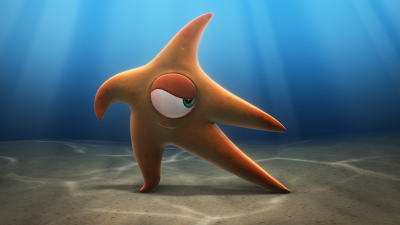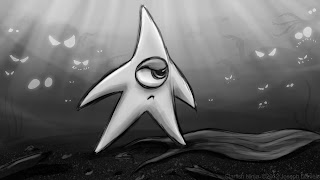What I mean here in saying "by hand" is that an effect that you might think is created by a complicated simulation or algorithm that is instead created frame by frame by an artist. Why? Because sometimes its FASTER. Her are a few examples:
Octopus Decloaking:
In the SFN Teaser, there are two quick shots showing the stealthy ninja assassin octopi that stalk our hero. Real world octopi have an incredible ability to adjust the pigment of their skin to blend into their surroundings. Maybe you've seen this clip:
In the world of my story, octopi are caricatured to be able to cloak and de-cloak as they move about, making them the perfect hired assassin or great for reconnaissance.
Instead of generating this effect with complex networks of animated procedural textures, I chose the low-fi route, and gained heaps of artistic control. I simply painted an animated alpha channel (an image that controls the opacity of a surface). Frame by frame, one frame after another, each successive image reveals more of the character than the last.
For this I used the open source software package Blender for its projection painting ability, which at the time I did it was new to Blender. Why Blender? We'll get to that in another post.
(The left image below shows alpha channel image sequence as it appears on the model, the right is the result that this has on the transparency of the model when rendered.)
My process was this: I started off with a black (transparent) texture over the model and saved it out as the first frame. Then I painted a little white along the edge of the eye, and saved it as frame two. As I went along, I would paint the suction cups to appear one by one, and veins of white that appeared to spread and snake along the surface of the character, until the whole surface was white (opaque). I ended up painting about 50 separate images that, when put in a sequence, will animate to show the octopus build out with some artistic flare.
While this took me about two hours to do, it is an effect that could be then plugged into a slider for an animator to fade through as desired, and could be calculated in near real time in Maya, which is a big deal. If I had used other methods it would take much longer to render, and time is money.
Final Shot Squid Arm Particles:
An effects artist named Jenna Kind helped generate and simulate particles for the collision between the squids long tentacled arm and the ground in the final shot of the teaser. In the composite, the particles were brought down in strength so they don't distract from the characters in such a short shot. But if you look close, you'll see a few cloudy wisps of sand that move out of the way as the arm crashes down. I was happy with the simulation, but it wasn't leading the eye in the way I wanted. So instead of spending hours or days tweaking the simulation to get the exact graphic shapes I wanted, I decided to spend about half an hour painting over a handful of frames in the sequence by hand.
Original Render
Particle Paintover in PS
CG Smears:
One of my favorite tumblr sites is the smears and multiples blog. A smear in animation is a frame or frames in which the artist chooses to distort proportions of a character or object to aid the audience in following a quick arc or movement that has been caricatured to where it would be hard to follow otherwise. It's a stylistic choice used to provide clarity.
With the technology we used to render the teaser, motion blur had to be cheated or in most cases left out completely. Motion blur can help the flow of movement in animation, but without it I was excited to draw from some of the fantastic cheats that we're developed with hand drawn animation. (As a side note, smears are present not only in the very stylized works of Tex Avery and Chuck Jones, but are also peppered judiciously through the hand drawn Disney films, as well as the modern works of Disney, Pixar, Dreamworks, Blue Sky, and the like. I even found an example of it in ParaNorman.)
 |
| A sequence of smears, slowed down to 50% speed. |
Here are some of my favorites. The last two are subtle, but they make a real difference if you see it with and without:
Breaking the Surface:
Two weeks ago, we looked at a shot where the camera breaks the surface and submerges. This was an interesting challenge for lighting, but also for compositing the elements of the shot together. Below we will look at the composite created by Curtis Cheung, as well as the paint-over tweaks I did on top to help the transition to the underwater setting.
If you're not used to looking at animation and picking apart details, the following .gifs may look identical. On first look, hopefully you will notice that the camera in the top sequence feels like it suddenly "pops" beneath the surface, where the transition in the second should feel softer and more natural.
There are a few things that I took into consideration in making the tweaks to this shot. The primary issue that makes it feel "poppy" is explored in the images below. On frame 28, the darkest and highest contrast is in the upper half of the frame. On frame 29, this inverts, and the bottom becomes significantly darker. When images are too dissimilar from one frame to another, they will appear to stutter or pop.
The other key thing I wanted was to see the adhesion of the water on the lens of the camera, and it really didn't come out in the render. I looked at a lot of photography taken by half-submerged cameras, and I really wanted to feel the water sticking to the lens.
If you compare those images, you'll see that there is something adjusted in all three frames on the final sequence, but most of it is in frame 28. In animation, the difference between a "pop" and a "slurp" may be as simple as one frame out of the 24 or 30 frames we see each second. Every frame counts, and in this shot, frame 28 was worth some extra effort.
Well, that wraps up my post for this week. I have more behind the scenes topics, most of which are less technical that the last couple have been, but I hope you're finding these interesting.
Leave a comment, subscribe at the top of the page, and pass this along to anyone you think might be interested. Spread the word, the ninja is coming!
If you're not used to looking at animation and picking apart details, the following .gifs may look identical. On first look, hopefully you will notice that the camera in the top sequence feels like it suddenly "pops" beneath the surface, where the transition in the second should feel softer and more natural.
 |
| Original Comp by Curtis Cheung |
 |
| Photoshop paint-over to ease transition |
The other key thing I wanted was to see the adhesion of the water on the lens of the camera, and it really didn't come out in the render. I looked at a lot of photography taken by half-submerged cameras, and I really wanted to feel the water sticking to the lens.
If you compare those images, you'll see that there is something adjusted in all three frames on the final sequence, but most of it is in frame 28. In animation, the difference between a "pop" and a "slurp" may be as simple as one frame out of the 24 or 30 frames we see each second. Every frame counts, and in this shot, frame 28 was worth some extra effort.
Well, that wraps up my post for this week. I have more behind the scenes topics, most of which are less technical that the last couple have been, but I hope you're finding these interesting.
Leave a comment, subscribe at the top of the page, and pass this along to anyone you think might be interested. Spread the word, the ninja is coming!















































